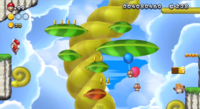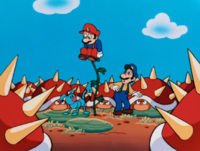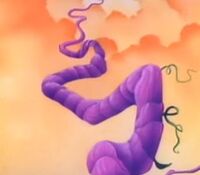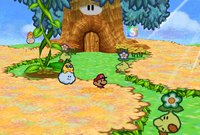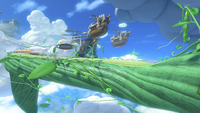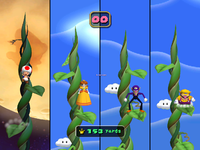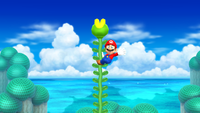Vine
- "Beanstalk" redirects here. For the location in Super Mario RPG: Legend of the Seven Stars, see Beanstalk (Super Mario RPG). For the character in Donkey Kong 64, see Beanstalk (character).
- This article is about the recurring beanstalk-like vines that pop out of blocks in the Super Mario series. For the naturalistic vines that the player swings from in the Donkey Kong Country series, see swinging vine.
| Vine | |||
|---|---|---|---|
Artwork from New Super Mario Bros. Wii | |||
| First appearance | Super Mario Bros. (1985) | ||
| Latest appearance | Mario Kart World (2025) | ||
| Effect | Climbable plant that leads to hidden areas, typically hidden within blocks | ||
| Variant of | Piranha Plant | ||
| |||
| |||
Vines, also referred to as beanstalks and occasionally called Ivy,[1] Magic Vines,[2] or Fine Vines,[3] are recurring climbable objects in the Super Mario franchise that debuted in Super Mario Bros. In that game and most subsequent appearances, vines are concealed within Vine Blocks, blocks that superficially resemble normal ? Blocks or Brick Blocks until they are struck. When the player character hits a Vine Block, the vine emerges and rapidly ascends up the opposite direction. Vines often lead to hidden subareas in the sky, like Coin Heavens.
Vines usually have Piranha Plant-like heads that flex their mouths as the vine extends, suggesting they may be related plants. The head disappears and the vine stops growing when it reaches an opposing surface, typically a ceiling.
History[edit]
This section is a stub. Please consider expanding it to include any missing information. Specifics: Yoshi's Story
Super Mario series[edit]

Super Mario Bros. / Super Mario Bros.: The Lost Levels / Super Mario Bros. Deluxe[edit]
Beanstalks first appear in Super Mario Bros., where they are activated to reach secret places such as Coin Heaven and Warp Zones. In World 8-2 of Super Mario Bros.: The Lost Levels, a beanstalk is required to reach the end of the level.
Super Mario Bros. 2 / Super Mario Advance[edit]
Unlike the previous game, in Super Mario Bros. 2, beanstalks are already grown in the level and do not need to be activated. They function identical to the chains and ladders found in other areas, and are sometimes suspended in midair.
Super Mario Bros. 3 / Super Mario Advance 4: Super Mario Bros. 3[edit]
In Super Mario Bros. 3 they match the color scheme of the world they are located in; brown for World 2, green for Worlds 3 and 4, blue for World 5, and white for World 6. One notable feature about the All-Stars and Advance versions is that the top of Beanstalks resemble Piranha Plant heads, a trait that started with Super Mario World and continued in many later games of the series.
Super Mario World / Super Mario World: Super Mario Advance 2[edit]
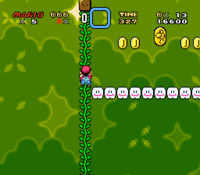
In Super Mario World, Beanstalks (also named Vines[4][5]) return to being green, and some grow toward breakable blocks. If Mario removes the blocks the stalk can continue rising, making shortcuts available. If the player is carrying an item such as a P Switch, the stalk cannot be climbed normally. The player can kick the item up, start to climb the Beanstalk, and then hold again to catch the item coming down while climbing. Like Jumping Piranha Plants, buds will change into pumpkins after the player completes Funky.
Super Mario 64 / Super Mario 64 DS[edit]
Conventional beanstalks are absent in Super Mario 64, but there are green poles that look like beanstalks extending down from a cloud in Wing Mario Over the Rainbow. One of them must be grabbed in order to collect one of the course's Red Coins. Another one of these poles, with a more organic texture and a pair of leaves at the top, occurs in Goomboss Battle in Super Mario 64 DS, where the player needs to climb it in order to reach a floating piece of log that leads to a bridge and then to reach the arena with Goomboss.
New Super Mario Bros.[edit]
Beanstalks later appear in New Super Mario Bros. In this game, in addition to growing upwards, they can grow downwards if the character hits the block containing the beanstalk from above with a ground pound. Unlike Super Mario Bros. 3 and Super Mario World, the tops of the Beanstalks are now red, while they otherwise look less like a Piranha Plant. Their stems also have a twisted appearance in this game.
New Super Mario Bros. Wii[edit]
Beanstalks return in New Super Mario Bros. Wii, serving the same function as in the other games, but having a slightly different appearance. The tips of the Beanstalk return to their original green appearance. Their stems also revert to their non-twisted appearance, and their lips are yellow. Also, in World 7, there is a Beanstalk on the World Map that leads the character to a back door from the World 7-Castle that takes the player right to Ludwig von Koopa. This can be accessed any time after finishing World 7-6.
New Super Mario Bros. 2[edit]
In New Super Mario Bros. 2, Beanstalks make a return, where they have their New Super Mario Bros. Wii appearance.
New Super Mario Bros. U / New Super Luigi U / New Super Mario Bros. U Deluxe[edit]
Beanstalks return in New Super Mario Bros. U and its port and New Super Luigi U, and act like the New Super Mario Bros. Wii variant. The New Super Mario Bros. U level Skyward Stalk and the New Super Luigi U level Beanstalk Jungle, both from Sparkling Waters, feature special giant Beanstalks throughout the level. The Leaf Platforms on these Beanstalks grow over time and act as temporary platforms that will fall after a while. When they are about to fall, their colors begin to change from green to yellow, then to red. Enemies such as Piranha Plants and Goombas can land on them. The Beanstalks also feature Bean Platforms that can roll in or out.
Super Mario Maker / Super Mario Maker for Nintendo 3DS[edit]
Vines make a return in Super Mario Maker and Super Mario Maker for Nintendo 3DS. They can be placed into stages either within or out of blocks. When used outside of blocks, players can extend their length, but when in blocks, they will grow up until the top of the stage or up to a ceiling. They can be used in all four styles, retaining their appearances, albeit with Piranha Plant heads added to their Super Mario Bros. and Super Mario Bros. 3 sprites. Shaking the beanstalk in the Super Mario World airship theme causes it to make an ancient wood pipe sound.
Super Mario Odyssey[edit]
Beanstalks make their debut in a 3D Super Mario game appearing in Super Mario Odyssey, with three uses.
In the Wooded Kingdom, Beanstalks are used to climb out of the Deep Woods. In order to make a Beanstalk appear, Mario must obtain a seed from a Steam Gardener, and then he must plant the seed in small patch of dirt that has light shining over it. These Beanstalks never disappear, allowing Mario to climb back out of the Deep Woods if he falls there again.
In other places such as the Snow Kingdom or the upper part of the Wooded Kingdom, Beanstalks are instead used to reach bonus areas in the sky, containing many coins and two Power Moons. They are accessed the same way, by finding a seed and planting it in a nearby patch of dirt. Unlike the Beanstalks in the Deep Woods, these ones disappear after Mario exits the bonus area, and the seed must be planted anew to reach the area again.
Sometimes, in other kingdoms like the Mushroom Kingdom, they are used to climb up to a certain area inaccessible by normal means. Like the Beanstalks in the Deep Woods, they never disappear.
Super Mario Maker 2[edit]
Vines return as course elements in Super Mario Maker 2. In the story mode hub, a Vine sprouts out of a Hidden Block which allows Mario to talk to Soundfrog. Also, in World Maker, placing a cloud with a path leading to it causes a beanstalk to appear for Mario to climb.
Super Mario Bros. Wonder[edit]

Vines reappear as objects in Super Mario Bros. Wonder. Vines can be spawned by hitting blocks containing them and by watering Wow Buds. Others, lacking their signature Piranha Plant-like heads, are pre-spawned and resemble the Vines of the Super Mario Maker series.
Aquatic variants of vines are also introduced, which are magenta in coloration, have hemispherical leaves, and are found in water courses such as Leaping Smackerel. Sometimes the Piranha Plant-like heads can eat through hard blocks. The Grappling Vine badge also grants the player who equipped it the ability to shoot a Vine that latches onto walls.
Super Mario Bros.: Peach-hime Kyūshutsu Dai Sakusen![edit]
In Super Mario Bros.: Peach-hime Kyūshutsu Dai Sakusen!, a beanstalk appears where it help Mario and the others escape the Spinies.
DIC cartoons[edit]
The Super Mario Bros. Super Show![edit]
A beanstalk appears in The Super Mario Bros. Super Show! episode "Mario and the Beanstalk", which in itself is a reference to Jack and the Beanstalk. The premise of the episode involves Mario and Luigi foolishly trading Princess Toadstool's Royal Cow for garbanzo beans, which the Princess rejects by sneezing them out of Mario's hand and into the soil, due to her allergy. The beans grows into a huge beanstalk overnight, which leads Mario's group up into the clouds, where they discover an enlarged King Koopa's castle.
After escaping from the castle, King Koopa summons several Hoopsters to stop Mario and friends' progress on their way back down the beanstalk. However, the Hoopsters are quickly defeated by having freshly-picked garbanzo beans thrown at them. Upon reaching the bottom, Luigi chops down the beanstalk with an axe, which brings King Koopa's entire castle crashing down with it.
The Adventures of Super Mario Bros. 3[edit]
Small Beanstalks can also be seen in the background of a few episodes of The Adventures of Super Mario Bros. 3. However, they are never integral to the plot of any episode.
Super Mario World television series[edit]
In the Super Mario World episode "Party Line", countless beanstalks are used as telephone lines (or rather, vines) for the Cave People of Dome City. After the concept of telephones proves to be unnecessary for the Cave People, Yoshi is given the job of eating all the vines.
Hotel Mario[edit]
A beanstalk also appears in a Hotel Mario cutscene. Luigi kicks an ! Block, and a beanstalk sprouts out which Mario and Luigi climb to go to Lemmy's High-ate Regency Hotel.
Super Mario RPG: Legend of the Seven Stars[edit]
- “Wow! Did you see that? It's a magical beanstalk! Hit the block once more to climb it.”
- —In-game text, Super Mario RPG: Legend of the Seven Stars
In Super Mario RPG: Legend of the Seven Stars, two beanstalks are seen. One is seen at the end of Bean Valley, which leads to an area of the same name that features floating, multi-colored spiral vines with a similar function. Another grows after a side quest in Rose Town, and leads to some secret items like the Lazy Shells.
Paper Mario[edit]
In Paper Mario, Mario must grow a beanstalk in Flower Fields to access Cloudy Climb and face off with Huff N. Puff for the Star Spirit Klevar. To grow it, Mario must first collect the Magical Bean, Fertile Soil, and Miracle Water, and destroy Huff N. Puff's Puff Puff Machine.
Mario Kart series[edit]
Vines are a major fixture of Sky Garden, a course seemingly based on Coin Heavens that appears in Mario Kart: Super Circuit, Mario Kart DS, Mario Kart Tour, and Wave 1 of the Mario Kart 8 Deluxe – Booster Course Pass. In all adaptations of the course, vines pop out of the clouds in the background and some interlaced ones make up parts of the road, interconnecting clouds. In Mario Kart Tour and Mario Kart 8 Deluxe, the leaves on the vines can be used as a shortcut.
A giant vine appears as the last portion of Cloudtop Cruise, a course similar to Sky Garden in Mario Kart 8 and Mario Kart 8 Deluxe. It is part of the road, and sprouts from a giant, rusted Vine Block. Some of its leaves can also be used as a shortcut to the finish line.
In Mario Kart World, a type of vine called the Ivy Piranha Plant can be used as a grindrail, appearing as part of multiple P Switch missions in Free Roam. Occasionally, the player can control an Ivy Piranha Plant's growth path.
Mario Party series[edit]
Mario Party 3[edit]
In Mario Party 3, beanstalks appear in the mini-game Parasol Plummet, where the characters fall from the sky and Hammer Bros. throw hammers at them.
Mario Party 5[edit]
In Mario Party 5, beanstalks appear in the mini-game Leaf Leap, where it slowly grows as the characters climb their leaves.
Mario Party 9[edit]
Beanstalks reappear in Mario Party 9 looking exactly as they were in New Super Mario Bros. Wii. In the Toad Road gameboard, a Beanstalk can be accessed landing on one of the Lucky Spaces. It takes the captain to a cloud to collect Mini Stars. Beanstalks also appear in the minigame Growing Up, where they get out of Brick Blocks as the players hit them.
Mario Party: The Top 100[edit]
In Mario Party: The Top 100, beanstalks reprise their role in the mini-game Leaf Leap.
Mario Party Superstars[edit]
In Mario Party Superstars, beanstalks reprise their roles in the mini-games Parasol Plummet and Leaf Leap.
Super Mario Party Jamboree[edit]
In Super Mario Party Jamboree, beanstalks appear in the first round of the Showdown mini-game Mario's Three-peat, which is Leaf Leap where they act exactly how they did before. At the end of the round, the beanstalks fully grow making the characters climb up to the next round being Bumper Balls.
Yoshi's New Island[edit]
In Yoshi's New Island, different beanstalks appear in Bouncy Beanstalk Walk.
Super Smash Bros. for Wii U[edit]
The giant beanstalk from the New Super Mario Bros. U level Skyward Stalk and New Super Luigi U level Beanstalk Jungle reappear in Super Smash Bros. for Wii U as a stage element on all four variants of the Mushroom Kingdom U stage. Occasionally, it grows in the middle of the stage and provides extra platforms for fighters to use.
Minecraft[edit]
In the Super Mario Mash-Up Pack in Minecraft, Chorus Fruit, Vines, Chorus Flowers, and Chorus Plants are replaced by Beanstalks.
Luigi's Mansion 3[edit]
In Luigi's Mansion 3, Luigi has to grow a vine on the Garden Suites area after defeating Dr. Potter in order to reach the elevator button to Paranormal Productions.
Mario Strikers: Battle League[edit]
In Mario Strikers: Battle League, Vines appear as goal-line decorations in the Strikers Club customization options for Mushroom Hill. Additionally, Vines appear surrounding the largest version of the stadium as well.
Gallery[edit]
- For this subject's image gallery, see Gallery:Vine.
Names in other languages[edit]
Vine[edit]
| Language | Name | Meaning | Notes |
|---|---|---|---|
| Japanese | つる[6][7]:61,70,150,200 Tsuru |
Vine | |
| ツル[?] Tsuru | |||
| マメの木[?] Mame no ki |
Beanstalk | ||
| 豆の木[8] Mame no ki | |||
| きょだいマメの木[9][10] Kyodai mame no ki |
Giant beanstalk | New Super Mario Bros. U, New Super Luigi U | |
| Chinese | 豆豆树[?] Dòudòu Shù |
Bean Tree | New Super Mario Bros. U Deluxe |
| 豆豆樹[?] Dòudòu Shù | |||
| 藤蔓[?] Téngwàn |
Vine | Super Mario Maker 2 | |
| Dutch | Slingerplant[?] | Bine | |
| French | Liane[?] | Liana | |
| Lierre[?] | Ivy | ||
| Haricot magique[?] | Magical bean | ||
| German | Ranke[?] | Tendril | |
| Italian | Liana[11][12] | Vine | Super Mario Bros. 2, New Super Mario Bros. U (one instant) |
| Vite[13] | Super Mario All-Stars | ||
| Pianta rampicante[14] | Creeper; lit. "climbing vine" | Super Mario Bros. 2 (e-manual) | |
| Viticcio[15] | Tendril | New Super Mario Bros. U | |
| Korean | 콩나무[?] Kongnamu |
Beanstalk | |
| Portuguese (NOA) | Trepadeira[?] | Vine | |
| Cipó[?] | |||
| Portuguese (NOE) | Trepadeira[?] | Climber (plant) | |
| Russian | Лоза[?] Loza |
Vine | |
| Бобовый стебель[?] Bobovyy stebel |
Beanstalk | ||
| Spanish | Tallo de Judía[?] | Bean stem | |
| Enredadera[?] | Vine |
Vine block[edit]
| Language | Name | Meaning | Notes |
|---|---|---|---|
| Japanese | つるブロック[7]:21,29,41,119,216 Tsuru Burokku |
Vine Block | Super Mario Bros., Super Mario Bros.: The Lost Levels, Super Mario Bros. 3, New Super Mario Bros., New Super Mario Bros. U |
References[edit]
- ^ Yamashita, Tatsumi (1987). The Official Nintendo Player's Guide. Tokuma Shoten. ISBN 999832369X. Page 28-29.
- ^ Tilden, Gail, et al. (June 1990). Nintendo Power Volume 13. Nintendo of America (American English). Page 14.
- ^ Hodgson, David S J. (October 21, 2003). Super Mario Advance 4: Super Mario Bros. 3 Prima's Official Strategy Guide. Prima Games (American English). ISBN 0-7615-4425-9. Page 38.
- ^ Nintendo Mario Mania Player's Guide (August 1991). Nintendo of America (American English). Page 41.
- ^ 1992. Nintendo Super NES Player's Guide. Nintendo of America (American English). Page 9, 12, and 14.
- ^ 1990. スーパーマリオワールド (Sūpā Mario Wārudo) instruction booklet (PDF). Nintendo (Japanese).
- ^ a b Sakai, Kazuya (Ambit), et al. (October 19, 2015). 『スーパーマリオブラザーズ百科: 任天堂公式ガイドブック』 (Super Mario Bros. Hyakka: Nintendo Kōshiki Guidebook). Tokyo: Shogakukan (Japanese). ISBN 978-4-09-106569-8.
- ^ Sakai, Kazuya, and kikai, editors (2018). 『スーバーマリオ オデッセイ 公式設定資料集』. Tokyo: ambit (Japanese). ISBN 978-4-19-864696-7. Page 139.
- ^ Skyward Stalk
- ^ Beanstalk Jungle
- ^ Super Mario Bros. 2 Italian manual. Nintendo of Europe (Italian). Page 8.
- ^ Canale New Super Mario Bros. U (March 1st, 2013). New Super Mario Bros. U - Nuvole di meringa 4 - Una liana, un guscio e una serie di 1-Up (Wii U). YouTube (Italian).
- ^ Super Mario All-Stars Italian manual. Nintendo of Europe (Italian). Page 19.
- ^ Super Mario Bros. 2 (3DS - Virtual Console) e-manual. Nintendo of Europe (Italian). Page 3.
- ^ Canale New Super Mario Bros. U (January 24, 2013). New Super Mario Bros. U - Miniere di caramella 2 - Terza Moneta Stella (Wii U). YouTube (Italian).
- Legumes
- Piranha Plants
- Climbable objects
- Hotel Mario
- LEGO Super Mario objects
- Mario Kart 8
- Mario Party 9
- New Super Luigi U objects
- New Super Mario Bros. objects
- New Super Mario Bros. 2 objects
- New Super Mario Bros. U objects
- New Super Mario Bros. Wii objects
- Paper Mario objects
- Super Mario Advance objects
- Super Mario Advance 4: Super Mario Bros. 3 objects
- Super Mario Bros. objects
- Super Mario Bros. 2 objects
- Super Mario Bros. 3 objects
- Super Mario Bros. Deluxe
- Super Mario Bros.: Peach-hime Kyūshutsu Dai Sakusen!
- Super Mario Bros. Special
- Super Mario Bros.: The Lost Levels objects
- Super Mario Bros. Wonder objects
- Super Mario Maker objects
- Super Mario Maker 2 objects
- Super Mario Odyssey objects
- Super Mario RPG: Legend of the Seven Stars objects
- Super Mario World objects
- Super Mario World 2: Yoshi's Island objects
- Super Smash Bros. series objects
- The Super Mario Bros. Super Show! objects
- Yoshi's Island DS objects
- Yoshi's Island: Super Mario Advance 3
